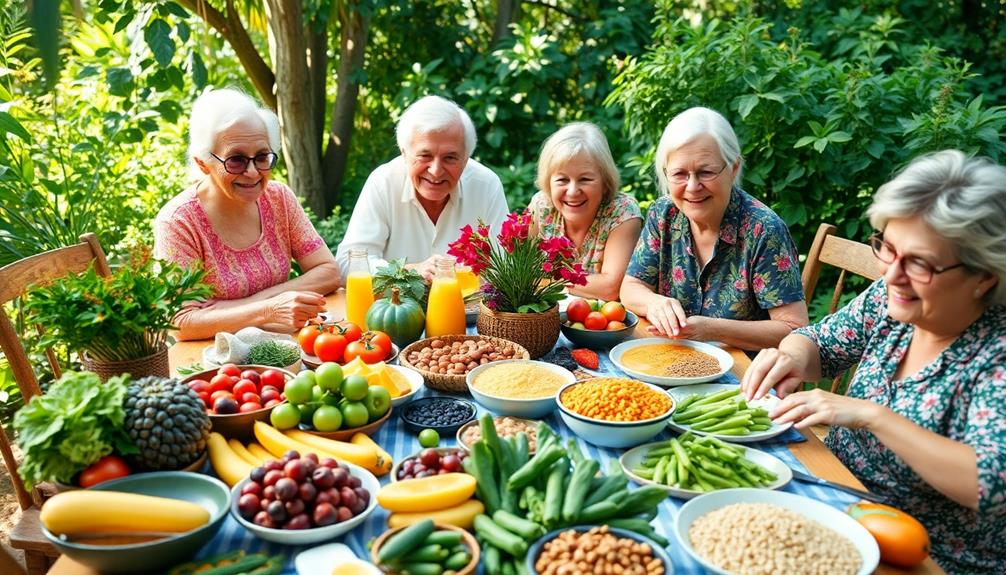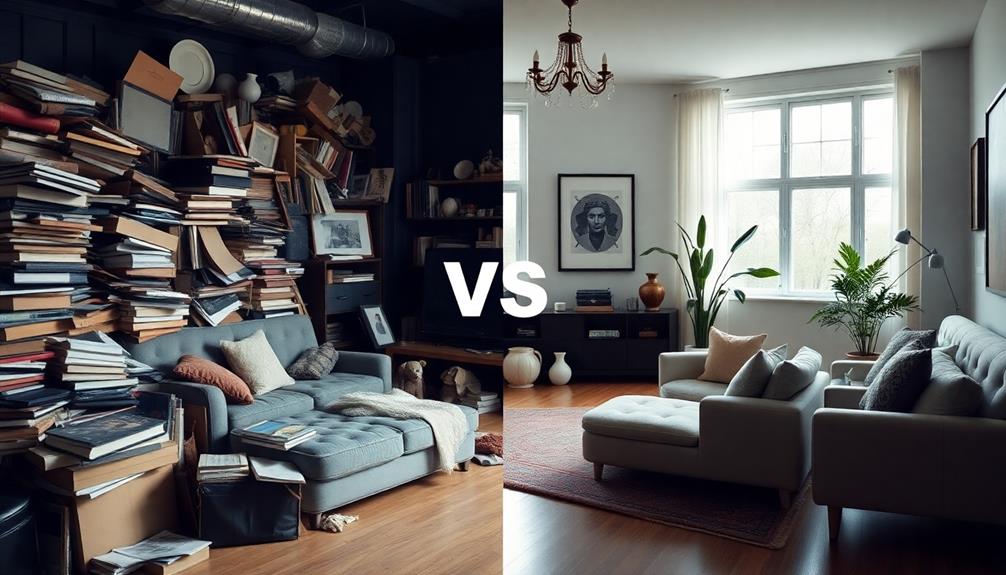Certain foods are linked to longevity in Blue Zones because they're mostly plant-based and nutrient-rich. You'll find that diets here consist of fruits, vegetables, whole grains, and beans, which help lower chronic disease risks. Legumes are eaten daily, while meat is limited, enhancing heart health. Healthy fats, particularly olive oil, also contribute to wellness. Additionally, community meals and strong social connections play an essential role in overall well-being. These traditional dietary patterns and social habits create a foundation for a longer, healthier life. If you're curious about specific meals and lifestyle practices, there's even more to explore.
Key Takeaways
- A predominantly plant-based diet, with 95% of meals from fruits and vegetables, reduces chronic disease risks and promotes longevity.
- High consumption of legumes provides essential nutrients and fiber, supporting heart health and lowering the risk of various diseases.
- Limited meat intake, averaging five times a month, contributes to lower heart disease risks while enhancing meal flavor.
- Healthy fats, primarily from olive oil, improve cholesterol levels and overall heart health, vital for longevity.
- Strong social connections and communal meals foster emotional well-being and contribute significantly to longevity in Blue Zones.
Overview of Blue Zones
For centuries, certain regions of the world have stood out for their remarkable number of centenarians, known as Blue Zones. These five areas—Ikaria in Greece, Ogliastra in Sardinia, Okinawa in Japan, the Nicoya Peninsula in Costa Rica, and Loma Linda in California—are celebrated for their high concentrations of long-lived people.
The term "Blue Zones" originated from Dan Buettner, who identified these regions during his longevity research by marking them with blue circles on a map. In these regions, diverse culinary practices often emphasize flavorful dishes, such as Red-Braised Pork Belly, that are enjoyed during communal gatherings.
In Blue Zones, environmental factors contribute considerably to longevity, accounting for about 70-80% of the health outcomes, while genetics play a lesser role at just 20-30%.
The diet in these areas leans heavily toward a plant-based lifestyle, with around 95% of food coming from plant sources. Beans, in particular, are a staple, reflecting the Mediterranean influence and providing essential nutrients.
Additionally, the community aspect is essential; strong social connections and a sense of purpose are critical elements that support overall well-being. Together, these factors create an environment where people thrive and live longer, healthier lives.
Key Dietary Patterns
One of the most striking aspects of the diets in Blue Zones is their strong emphasis on plant-based foods. Residents consume a mainly plant-based diet, with up to 95% of their meals featuring fruits, vegetables, whole grains, and legumes. This approach is linked to lower mortality rates and reduced risks of chronic diseases.
Legumes are a dietary staple, with an average of at least half a cup consumed daily, providing high protein content while being low fat, which promotes heart health and longevity. Meat is limited to about five times a month, emphasizing flavor over quantity, further reducing heart disease risks.
Whole grains and nuts are also key components, known for their nutrient density and fiber content, which support heart health. Minimizing processed foods is another important aspect of these diets.
Additionally, healthy fats, particularly olive oil found in Mediterranean Blue Zones, improve cholesterol levels and overall heart health.
Here's a summary of these dietary patterns:
| Dietary Component | Benefits | Frequency |
|---|---|---|
| Fruits & Vegetables | High in nutrients, low fat | Daily |
| Legumes | Heart health, longevity | At least once daily |
| Whole Grains | Nutrient density, fiber | Regularly |
Importance of Plant-Based Foods
Plant-based foods play an essential role in promoting longevity and overall health. In Blue Zones, residents consume a mainly plant-based diet, with around 95% of their meals made up of fruits, vegetables, legumes, and whole grains. This high intake is linked to lower risks of chronic diseases, making these longevity foods crucial for well-being.
In addition, traditional dishes from different cultures, such as Brazil's emphasis on fresh ingredients like cassava and leafy greens, showcase the importance of incorporating diverse plant-based foods into your diet traditional Brazilian dishes.
Leafy greens like spinach and kale are particularly important, as their nutrient density provides numerous health benefits. Incorporating these greens into your meals can enhance your overall nutrient intake and support a healthier lifestyle.
Moreover, the use of healthy fats, mainly olive oil, contributes to improved cholesterol levels and heart health among Blue Zone residents.
Emphasizing whole foods and minimizing processed ingredients helps create a foundation for better health outcomes. By focusing on a plant-based diet rich in legumes, whole grains, and healthy fats, you can greatly improve your chances of living a longer, healthier life.
Ultimately, adopting these dietary patterns can lower your risks of chronic diseases and promote longevity, allowing you to thrive well into your later years.
Role of Legumes and Whole Grains
When you think about boosting your longevity, legumes and whole grains should be at the top of your list. Packed with protein and essential nutrients, these foods play a vital role in promoting heart health and reducing chronic disease risks.
For instance, dishes like Mushroom Masala can be a delicious way to incorporate legumes into your diet. Incorporating them into your daily meals can greatly enhance your overall well-being and longevity.
Nutritional Benefits of Legumes
Legumes and whole grains are nutritional powerhouses that play a vital role in promoting longevity and overall health. By incorporating legumes, like beans and lentils, into your daily meals, you can reap significant nutritional benefits. These foods are rich in protein and fiber, which not only help you feel fuller longer but also support heart health.
The high fiber content in legumes can reduce the risk of chronic diseases, including heart disease and type 2 diabetes. For example, traditional dishes from various cultures, such as Muamba De Galinha, showcase the use of nutritious ingredients like beans, which enhance health and provide rich flavors.
In Blue Zones, the average bean consumption is four times higher than in the U.S., showcasing their importance as a staple food. Eating legumes regularly helps maintain stable blood sugar levels, contributing to better metabolic health.
When combined with whole grains, such as 100% whole wheat products or sourdough, you further enhance these benefits. A focus on plant-based diets filled with legumes and whole grains aligns with longevity research, which suggests these foods combat aging-related diseases and improve your quality of life.
Whole Grains and Longevity
Incorporating whole grains into your diet can greatly enhance your longevity and overall health. In Blue Zones, residents regularly consume whole grains, particularly sourdough and 100% whole wheat bread, which help maintain nutritional profiles that support heart health.
These minimally processed grains are rich in essential nutrients, contributing to reduced risks of chronic diseases like heart disease and diabetes. Additionally, dishes like Heirloom Bean Stew showcase the importance of legumes, which are often paired with whole grains for a nutrient-dense meal.
Legumes, such as beans and lentils, are also staples in these communities, with an average intake of at least half a cup daily. This high consumption—about four times more than in the U.S.—is vital for promoting longevity, given their high protein and fiber content.
Whole grains and legumes together form a nutrient-dense combination that contributes to lower mortality rates.
Fish and Dairy Considerations
When it comes to fish, moderation is key—aim for small servings a few times a week to reap health benefits without overdoing it.
Incorporating dishes that feature healthy ingredients, such as Kue Putu, can provide a delightful balance to your diet.
As for dairy, you might want to contemplate alternatives, especially if you're lactose intolerant, since many in Blue Zones prefer fermented goat or sheep's milk.
Balancing these choices can help you align with the longevity principles seen in these regions.
Fish Consumption Guidelines
Emphasizing sustainable choices, fish consumption guidelines in Blue Zones recommend limiting intake to fewer than 3 ounces, up to three times a week. This approach focuses on moderate consumption of small fish like sardines and anchovies, which are rich in Omega-3 fatty acids and other health benefits.
Additionally, incorporating a variety of nutrient-dense foods, such as healthy snacks like Candy Corn Fruit Parfaits, helps to diversify your diet and promote overall wellness. By opting for smaller fish, you not only enjoy these nutrients but also support sustainable practices by choosing non-threatened species and avoiding overfishing.
While fish is beneficial, it's important to remember that it's not vital for longevity. You can reap the rewards of a healthy diet by incorporating fish in moderation, enriching your meals without excessive intake.
Dairy consumption in Blue Zones tends to be low, with goat milk and sheep's milk being preferred options. These are often consumed in fermented forms, aiding digestion and catering to those with lactose intolerance, which affects around 60% of the population.
Dairy Alternatives and Choices
Dairy alternatives have gained popularity as more people seek options that align with their dietary needs and preferences. In Blue Zones, dairy consumption is minimal, often favoring goat and sheep's milk, typically in fermented forms to enhance digestion and reduce lactose intolerance issues, affecting about 60% of individuals. While fish consumption is limited, emphasizing moderation, it's important to take into account ethical aspects like choosing non-threatened species.
Here's a quick comparison of dairy and non-dairy options:
| Dairy Options | Non-Dairy Alternatives |
|---|---|
| Goat Milk | Almond Milk |
| Sheep's Milk | Soy Milk |
| Fermented Yogurt | Coconut Yogurt |
| Cheese (limited) | Cashew Cheese |
Incorporating these non-dairy alternatives allows you to enjoy the health benefits associated with dairy while aligning with sustainable practices. Remember, while fish isn't essential for longevity, when consumed, it should be done thoughtfully and ethically. By choosing wisely, you can enjoy a balanced diet that reflects the longevity principles found in Blue Zones.
Hydration and Beverage Choices
Staying hydrated is essential for maintaining overall health and well-being, especially in regions known for their longevity, such as the Blue Zones. Residents in these areas prioritize hydration by drinking at least seven glasses of water daily, often complemented by traditional beverages like cranberry punch that enhance hydration while being festive. This commitment to water supports not just health but longevity itself.
In addition to water, coffee plays a significant role in the beverage choices of Blue Zone inhabitants. Regular coffee consumption is linked to lower rates of dementia and Parkinson's disease, promoting cognitive health.
Similarly, green tea is a staple due to its antioxidant properties and association with reduced heart disease risk.
Moderate consumption of red wine, typically two to four glasses a day, is another common practice. The high antioxidant content in red wine contributes to its potential longevity benefits.
On the other hand, soft drinks are largely avoided in Blue Zones. Instead, residents opt for natural beverages that enhance hydration and support health.
Cultural Aspects of Eating
In Blue Zones, the way people eat plays a significant role in their overall health and longevity. Cultural traditions shape dietary habits, with recipes passed down through generations that prioritize locally sourced produce and seasonal fruits.
This focus on community-oriented meals can be likened to the Southern tradition of dishes like squash casserole, which brings families together during gatherings. When you join family and friends for a meal, it's not just about nourishment; it's a communal activity that fosters enjoyment and strengthens community ties.
This emphasis on food as a shared experience enhances mindfulness around eating, allowing you to savor every bite. Elders often share intergenerational knowledge, teaching younger generations traditional cooking methods that promote wholesome food practices.
By valuing these nutritious rituals, communities guarantee that healthy eating becomes a cherished part of daily life. The focus on pesticide-free, locally sourced ingredients reflects a cultural commitment to sustainability and health, making fresh produce easily accessible.
In Blue Zones, meals are more than just sustenance; they're a celebration of life, relationships, and heritage. This holistic approach to eating not only nurtures the body but also enriches the spirit, demonstrating that food, when enjoyed together, can be a powerful contributor to longevity.
Social Connections and Longevity
While you might think of diet as the primary factor in longevity, social connections play an essential role in determining your overall health and lifespan. In Blue Zones, strong social ties correlate with lower mortality rates, thanks to the emotional support and shared healthy habits within communities.
Traditional meals like Yeselata and communal eating foster these connections, as they encourage people to gather and share nourishing food. Here are three key benefits of social connections:
- Intergenerational Living: In Blue Zones, families often live together, fostering strong family bonds. Grandparents caring for grandchildren not only enhance emotional support but also contribute to lower mortality risks.
- Moai Networks: These close-knit social groups promote healthy habits and positive lifestyle changes. Being part of a moai means you're more likely to engage in activities that benefit your health.
- Communal Meals: Regularly sharing meals with others enhances social interactions and a sense of belonging. This practice is linked to improved mental health and overall well-being.
Engaging in community activities, including faith-based gatherings, further strengthens these social connections.
Practical Tips for a Blue Zone Diet
Nurturing your social connections can naturally lead you to adopt a Blue Zone diet, which emphasizes wholesome, nutrient-rich foods.
Start by focusing on a mainly plant-based diet, ensuring at least 95% of your meals consist of vegetables, legumes, whole grains, and nuts. Incorporate legumes like beans and lentils daily—aim for at least half a cup—as they're nutrient-dense and linked to lower mortality rates.
Limit your meat consumption to about five times a month, keeping portions small (around 2 ounces). This approach allows you to enjoy meat for flavor rather than as a staple. Use healthy fats, such as olive oil, as your primary dietary fat, promoting better heart health and cholesterol levels.
Don't forget the power of communal meals. Share your meals with family and friends to strengthen social connections, as these shared experiences contribute to your overall well-being.
Frequently Asked Questions
Why Do Blue Zone People Live Longer?
Blue Zone people live longer due to their plant-based diets, regular physical activity, and strong social connections. You'll find their lifestyles emphasize community support, mental well-being, and a balanced approach to health, enhancing their longevity.
What Are Blue Zone Longevity Foods?
Imagine a vibrant garden bursting with colors; that's your plate in Blue Zones. You'll savor plant-based meals, legumes, healthy fats from olive oil, and seasonal produce, all fostering energy and enhancing your well-being.
What Are the Secrets of Blue Zone Longevity?
You'll discover that the secrets of Blue Zone longevity include a strong sense of community, regular physical activity, stress management, and a plant-based diet. Embracing these lifestyle habits can greatly enhance your well-being and lifespan.
What Are the Key Factors in Aging Well According to the Blue Zones?
To age well, focus on strong social connections, regular physical activity, and a plant-based diet. Embrace community engagement and moderation in alcohol consumption, as these factors greatly enhance your overall well-being and longevity.
Conclusion
Incorporating the dietary habits of Blue Zones can be a game-changer for your health and longevity. By embracing plant-based foods, legumes, whole grains, and mindful hydration, you're not just adding years to your life; you're adding life to your years. Remember, it's not just about what you eat, but how you connect with others over meals. So, immerse yourself in this vibrant way of eating and watch your well-being soar to astronomical heights!









